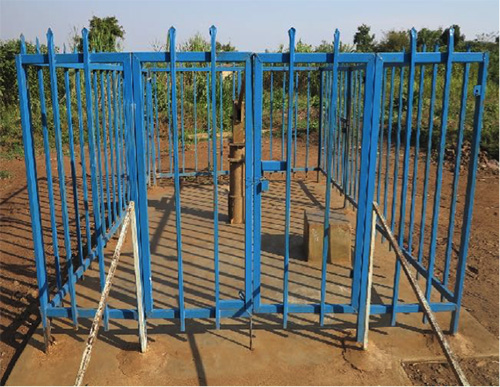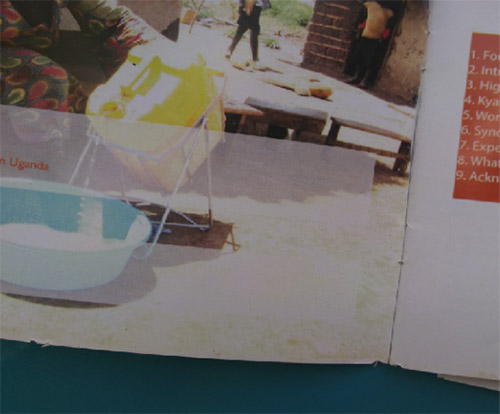As I skimmed through the first pages of the shiny brochure of the ‘Inclusive WASH’ project, I suddenly recognized some of the people that the leaflet depicted in its photograph-filled spread: Odongo, a Sudanese man with paralyzed legs who pumped water from a borehole; Claire, a Congolese woman with one arm and one leg who poured water into a basin with the help of an iron scaffold that held a jerry can, a plastic container for storing and transporting water; and Vitali, an elderly Burundian man with legs withered by polio, who was shown receiving instructions on how to use the iron scaffold with the jerry can.
The ‘Inclusive WASH’ project was implemented by an international aid organization with the aim to enhance access to water, and to improve sanitation and hygiene for people with disabilities through inclusive technology design. As the project officially came to an end only shortly after I started my fieldwork in the Kyangwali refugee settlement in Uganda, I knew that the brochure in my hands was supposed to account for the success of the project. Nevertheless, I was presented with a different picture of how the technologies designed for and provided by the project were eventually used by Odongo, Claire, Vitali and other people with disabilities in Kyangwali.
In this blog post I enquire about what happens when socio-cultural specific normative assumptions incorporated into technologies and their design travel within disability and development programs to other parts of the world, and thus encounter unfamiliar configurations between bodily (in)dependence and personhood. I argue that the difference between what I experienced in my own encounters with people with disabilities and the image presented in the brochure stems from a partial mismatch of assumptions about bodies and persons that were reflected in the design of the assistive technologies and the logics of the aid project at large.
Assistive technologies?
The aid organization’s brochure states that the design of their technologies aimed at ‘[…] reduced dependence [of people with disabilities] on other people for WASH [water, sanitation and hygiene] needs’. With a ramp, a concrete block to sit on, and a handle put at a height for everyone to reach, the design of the boreholes set up by the organization promised access for wheelchair-users as well as for people who were not able to stand, while the rails were thought to help people with impaired sight to find their way to the borehole on their own.

The path to the borehole with the blue iron scaffolding that was designed to increase access for people with disabilities in the camp. Photo Credit: Maria-Theres Schuler.
Another technology that promoted the ideal of disabled people who can do as much as possible on their own is the ‘jerry can tipper.’ The iron scaffold shown in the image below was designed to reduce the strength needed to handle a jerry can, as one only needed to tilt the device in order to pour water, instead of lifting the whole jerry can.

A photo taken of a page in the ‘Inclusive WASH’ brochure. Photo credit: Maria-Theres Schuler.
Technologies within the social fabric of the refugee settlement
The people with disabilities I interacted with in Kyangwali largely appreciated the project’s new boreholes, even though they did not use them as intended. Odongo who lived in Kyangwali without close kin usually moved with the jerry can on his hand-crank tricycle to the borehole, where he always found someone to pump water for him. Before and after school time, the boreholes were surrounded by children and teenagers—it seemed to be one of their meeting points—and someone was always on hand to help out. As in other African contexts it was very common for children in Kyangwali to be responsible for fetching water (see e.g. Livingston 2005, 215; Dahl 2014, 638). People with disabilities without offspring similarly managed to find someone to collect water for them, be it neighboring children, siblings, or their spouses. When I asked Claire, who also appeared in the brochure, she had this to say about the inclusivity of the boreholes:
‘‘Yes, it helped, it helped very much. [The aid project] put a lot of water here. Today, children fetch [water] wherever they would wish” (3/5/2015).
Children were not the only ready helpers. Support from other sources was also crucial for any household activities that needed water. One day I observed Claire cooking. She stabilized an iron pot with her one leg on the small stove and used her one arm to stir the porridge with a wooden spatula. As she used a crutch for every small step she took, Claire was not able to carry things and therefore asked her children or husband to bring her certain ingredients, to remove a pot from the fire, or to add water to a dish. This was however not different from what I experienced in other families without members with disabilities: cooking was a collaborative family activity especially for the elder children, as were other household chores. For instance, Daniel, a father who was not able to leave his bed due to a hip injury after a motorcycle accident, had his daughter bring him a cup and a basin to the bed and pour the water over his hands after he was done eating. The jerry can tipper provided by the aid organization stood unused in the corner of the room.
In many cases I found the jerry can tippers lying idle amongst other belongings or set aside behind people’s huts. The only person I saw actively use this technology was Vitali. The iron scaffold of the tipper was placed between his mattress and the parked tricycle in his one-room hut, and he used it to tip water into a drinking cup, or to wash his hands before eating. A neighboring family cooked for him on a daily basis, and during my visits I often encountered one of the family’s daughters who brought a pot of boiled potatoes or maize porridge with beans and collected the dirty dishes from the day before. If Vitali needed to wash clothes, he also received help from neighbors who brought water into his compound and helped pour it into his washing basins. Vitali’s everyday routines and the help he received reflect an important factor that the project’s water storage technology did not take into consideration in its design: in the settlement, there are different places where one eats, washes dishes or clothes, bathes children, and cooks. The range of locations where water is needed daily means that any assistive technology has to be mobile. Perhaps because of its unwieldy design, it turned out to be is easier for people with disabilities, as well as for the people that supported them, to merely carry the jerry can to these different places, rather than to move the whole iron scaffold.
Towards a revaluation of dependency for technology design
Anthropologists have drawn attention to independence as a significant marker of difference about how disabled bodies are viewed in diverse contexts: while in Western societies the independence of people with disabilities is promoted in line with an individualized ideal of personhood through disability activism and rehabilitation, independence is not such a relevant marker for much of life in Sub-Saharan Africa (Livingston 2005, 10; see also Ingstad and ReynoldsWhyte 2007; Ginsburg and Rapp 2013). The recent works of James Ferguson (2015) and China Scherz (2014) are important contributions for valuing dependency differently, although neither deals with disability explicitly. They emphasize the on-going importance of relations of patronage for how people who live in contexts with little formal support survive, drawing on often kinship-based networks of mutual exchange and obligations. They argue that it is exactly through investing in such interdependent relations that one achieves personhood.
Relations of dependence become of special significance for people with disabilities who were forcibly displaced. As they often lost or were separated from family and other caregivers in their flight from their home countries, the creation and cultivation of such relationships becomes an even more vital activity. Dependence can signify a sign of connectedness and belonging that importantly enables one to make claims for assistance, instead of merely being something inherently negative to be avoided by all means. The technologies and individualistic model of disability that the aid organization implemented through their project did not fit well into the social fabric of the settlement, where social ties turned out to be more critical sociocultural technologies for disabled people to access and use water. The iron scaffolding and the inclusively designed boreholes that merely focus on enabling an independent disabled actor undermine the role that relations of dependence play in the emergence of personhood. Instead of designing technologies from a presumed model of disability that promotes the ideal of an autonomous self, it may be more useful to instead pay attention to different kinds of dependencies, some of which might be more desired or problematic than others.
References
Cupitt, Rebekah. What the $@#! Is an ‘Implication for Design’? Platypus. Accessed on 11th September 2018. http://blog.castac.org/2017/03/implication-design/.
Dahl, Bianca. 2014. ‘Too Fat to Be an Orphan’: The Moral Semiotics of Food Aid in Botswana, Cultural Anthropology 29 (4): 626–47. https://doi.org/10.14506/ca29.4.03.
Ferguson, James. 2015. Give a Man a Fish: Reflections on the New Politics of Distribution. Duke University Press.
Ginsburg, Faye, and Rapp, Rayna. 2013. Disability Worlds, Annual Review of Anthropology 42 (1): 53–68. https://doi.org/10.1146/annurev-anthro-092412-155502.
Ingstad, Benedicte, and Reynolds Whyte, Susan. 2007. Disability in local and global worlds. University of California Press.
Livingston, Julie. 2005. Debility and the Moral Imagination in Botswana. Indiana University Press.
Scherz, China. 2014. Having People, Having Heart: Charity, Sustainable Development, and Problems of Dependence in Central Uganda. University of Chicago Press.

1 Comment
This a good observation maria,the problems of aid organizations tend not to consult the people intended to benefit from their aid so many times the beneficiaries what some thing different but since aiders dictate on their money people are left with no choice but to let them do what they wish .this programs are sometimes designed in the city after consulting the people who live in the city at take many years without visiting were they come from thus making them disconnected with reality in matters of their villagers and yet they are the ones who are consulted.so I for one I would suggest that aid organization should consult the benefactor’s .read this book called the Lords of poverty and you may get an insight why this aid projects are misplaced and do not benefit the community intended for.good peace of work good luck Maria .
1 Trackback